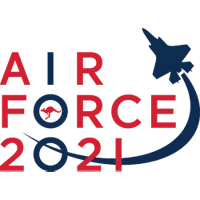

AIR FORCE 100 LIMITED EDITION MEDALLIONS
Centenary of Air Force Official Online Shop
An Exceptional Collection
The stunning Air Force 100 Limited Edition Medallion collection plays a special part in the commemoration of the Air Force Centenary in 2021.
A total of 12 limited-edition proof quality medallions to be released. Each is minted from brass alloy and finished in highly polished silver. Every medallion features artwork by Drew Harrison, one of Australia's leading military aviation artists, and also includes a schematic of the aircraft in frosted silver. The reverse each medallion features the Air Force Centenary logo.
Limited Release: 1,000 individual medallions. 1,000 sets.
Material: Brass alloy with sterling silver plate.
Finish: Mirror polished and frosted with full colour over-print.
Size: 50mm x 4.5mm thick.
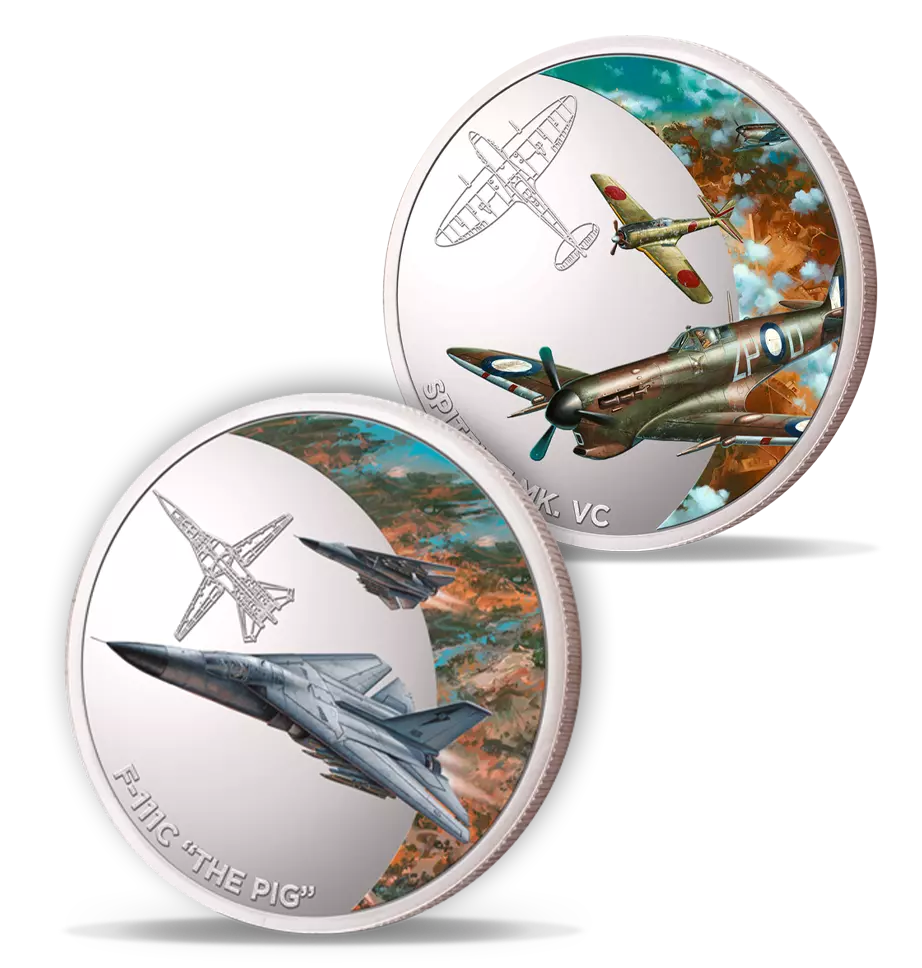
SERIES II
F-111C LIMITED EDITION MEDALLION
The F-111 entered service with the RAAF after controversial delays and technical difficulties. Going on to be one of the longest-serving strike bomber aircraft, the F-111 was operated by 82 Wing, including 1 and 6 Squadrons at Amberley, Queensland until its retirement from service in December 2010. The F-111 or more affectionately 'The Pig', holds a lasting legacy of its status as a regional deterrent.
The medallion features an F-111C from Drew Harrison's Seek, Strike and Return.
-
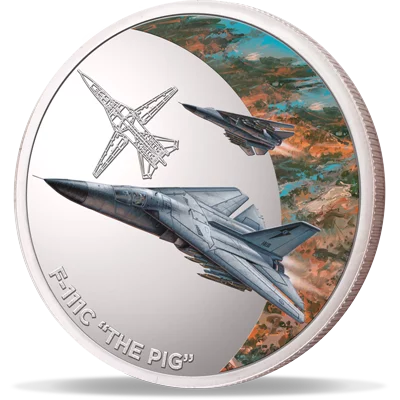
FRONT
-
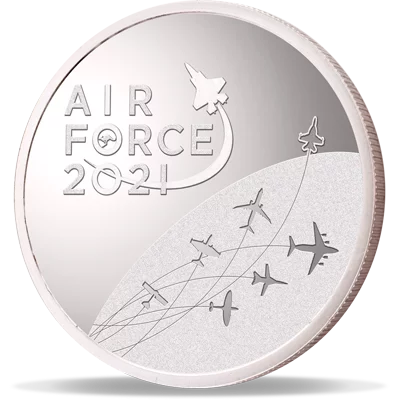
BACK
-

PRESENTATION CASE
-
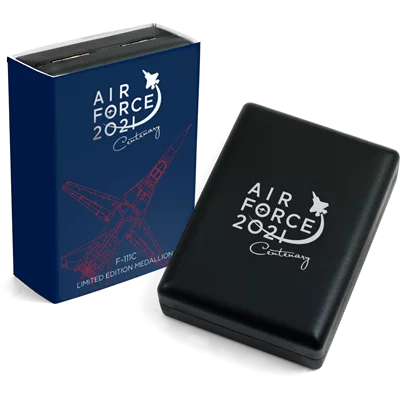
PACKAGING
SOLD OUT
SEEK, STRIKE AND RETURN
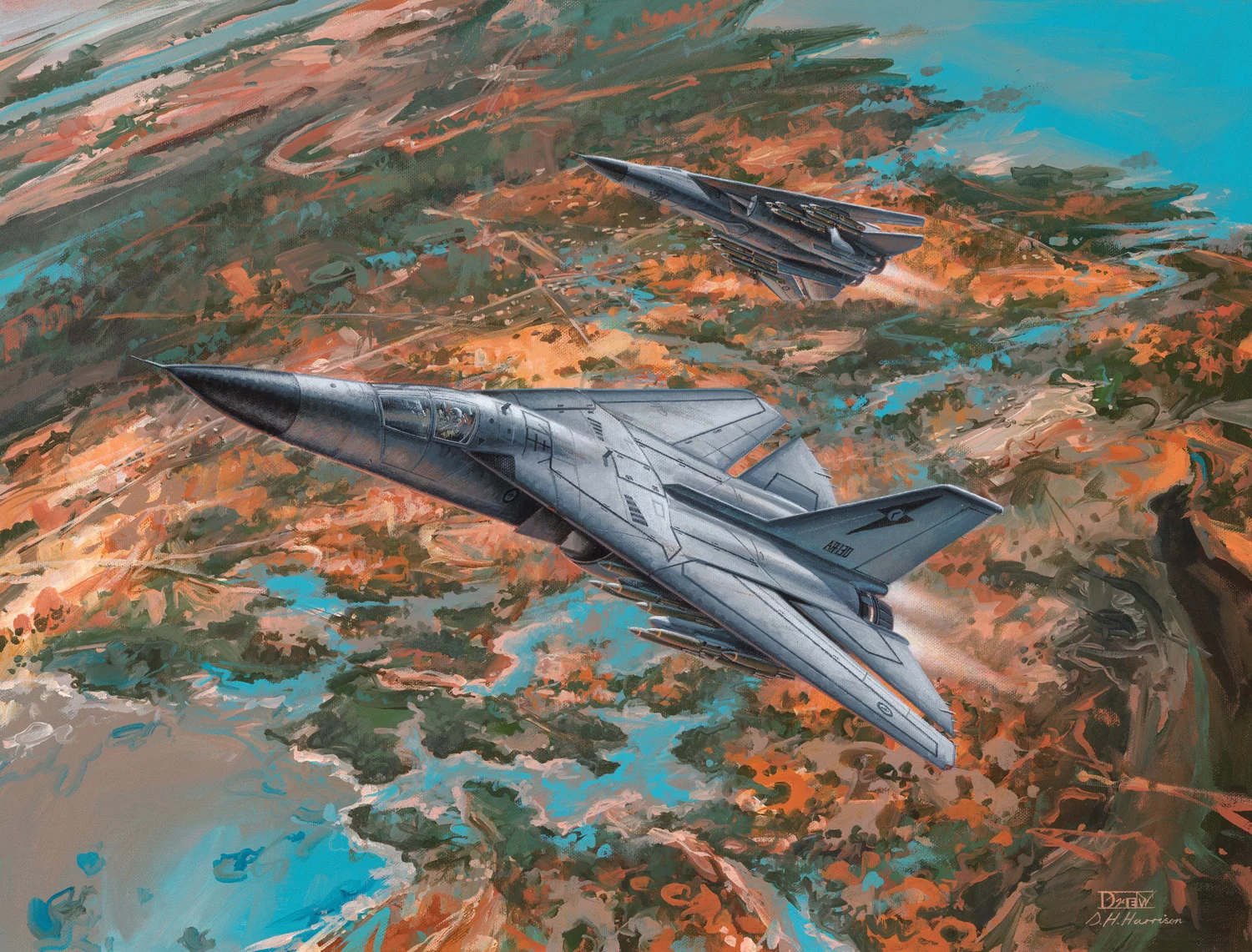
Never has there been a more controversial aircraft in RAAF service as the General Dynamics F-111. The ubiquitous and highly capable strike bomber attained several achievements in Australian service before retirement in December 2010. During nearly 37 years of duty it was affectionately known as 'The Pig' and operated by 82 Wing out of Amberley, Queensland. A8-130 (6 Squadron) and A8-147 (1 Squadron) were F-111C models shown here late in life fully 'bombed up' over the Northern Australian coastline.
C-130 Hercules Limited Edition Medallion
The legendary Lockheed C-130 Hercules has a long association with the RAAF, with its beginnings in December 1958. Taking on a range of roles from tactical and troop deployment to disaster relief and humanitarian operations, the ability to take-off and land on short and unsealed runways was paramount in combat zones and saw the deployment of the aircraft into the Middle East Area of Operations (MEAO) from 2003 onwards.
The medallion features a C-130 Hercules from Drew Harrison's First and Foremost.
-
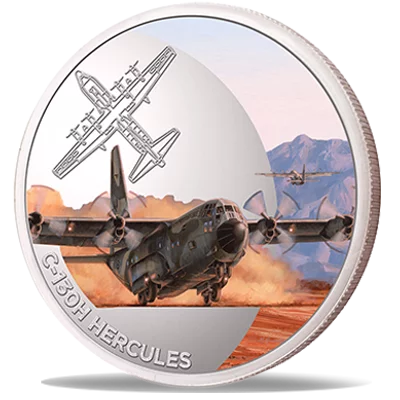
FRONT
-

BACK
-
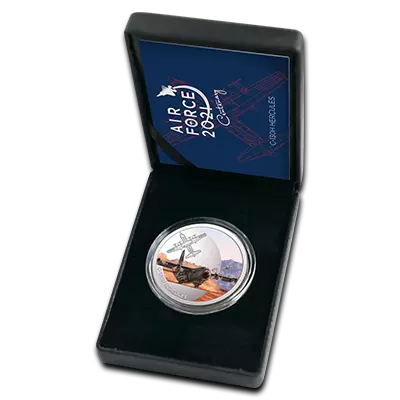
PRESENTATION CASE
-
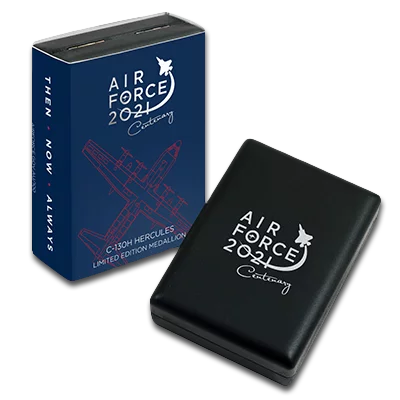
PACKAGING
FIRST AND FOREMOST
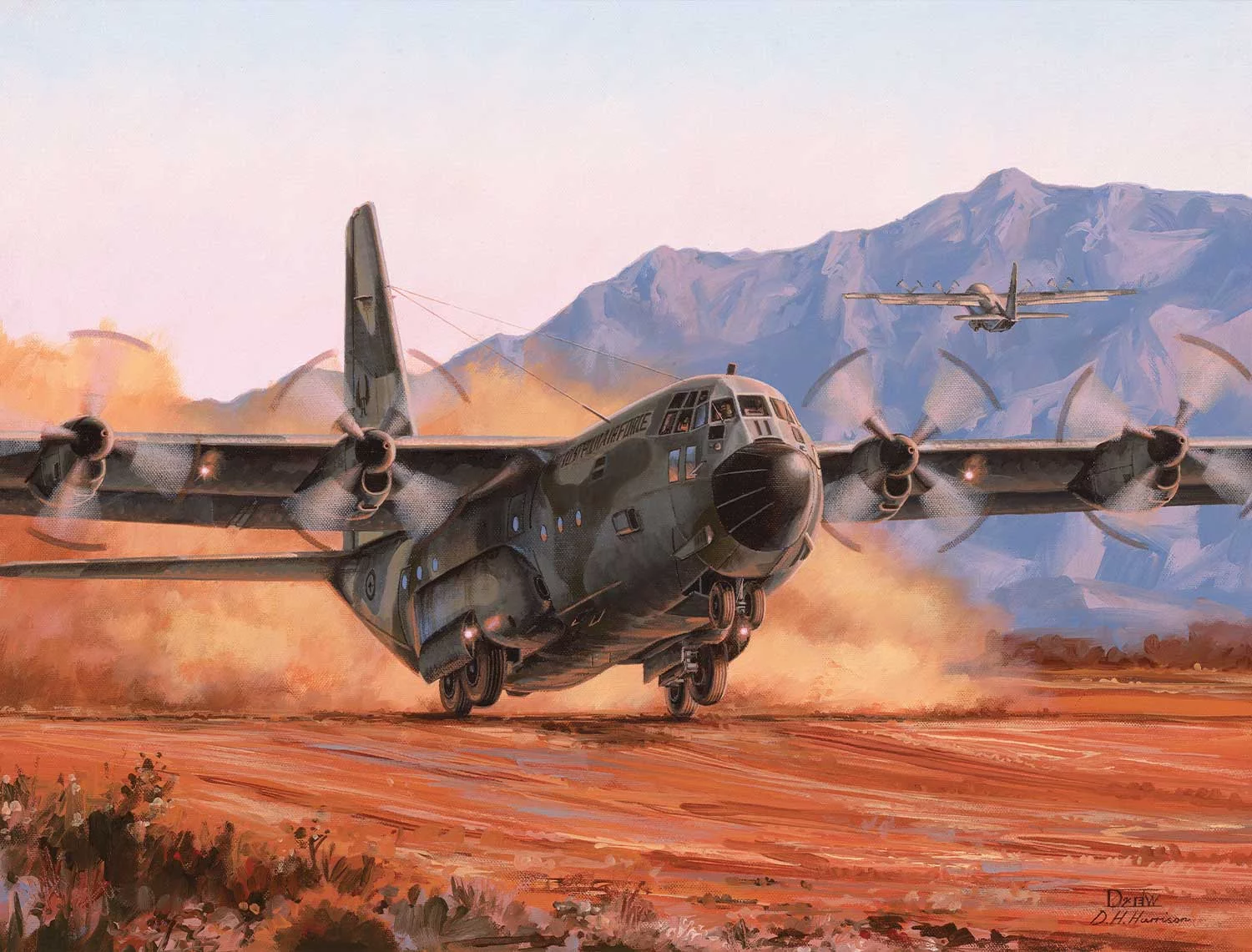
Few aircraft have achieved the same legendary status as the Lockheed C-130 Hercules. The RAAF's association with the transport began in December of 1958 when the first of twelve A models replaced an ageing Dakota fleet. However, this was only the start of a long association with C-130s. Over sixty years the C-130 fleet has operated many roles including tactical along with humanitarian and disaster relief. Key to these operations has been the ability to take-off and land on short, unsealed runways often to deliver troops or equipment into combat zones.
Beginning in February 2003 the RAAF's Hercules aircraft operated in the Middle East Area of Operations (MEAO). Between 2006 and 2008 37 Squadron deployed within the MEAO, alternating between crews of the C-130H and newer C-130J models. During that time 37 Squadron lived up to its motto of 'Foremost'. C-130H, A97-011 was one of the airframes delivered in 1978 that served with both 36 and 37 Squadrons. By the late 2000s it was deployed to the MEAO as part of 37 Squadron before making a final flight from Richmond to the RAAF Museum at Point Cook on retirement in December 2012. Here it remains on display with other variants of the RAAF's Hercules workhorse.
Lancaster Bomber Limited Edition Medallion
One of the thousands of aircraft and personnel to fly night operations as part of Bomber Command over European Targets, the illustrious Avro Lancaster assigned code AR-G and with the call sign "G" for George was operated by 460 Squadron RAAF. First flying to Berlin on January 16, 1943, "G" for George completed 90 operations during WWII and attained the second-highest mission tally of all Lancasters, routinely flying night operations over enemy territory.
The medallion features a Lancaster Bomber from Drew Harrison's Into the Cauldron.
-

FRONT
-

BACK
-
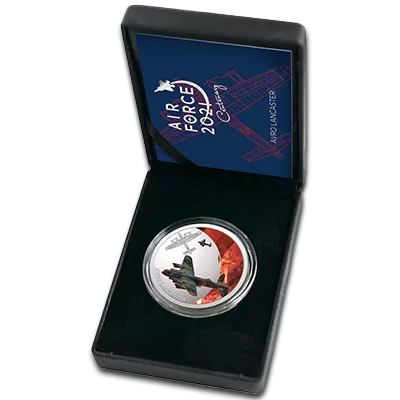
PRESENTATION CASE
-
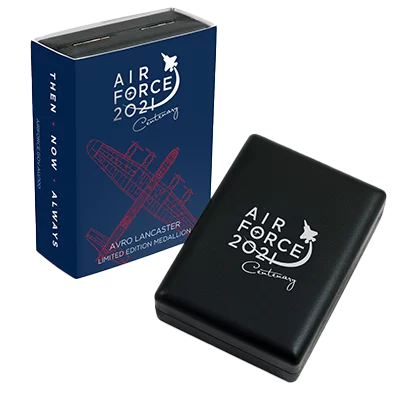
PACKAGING
SOLD OUT
INTO THE CAULDRON
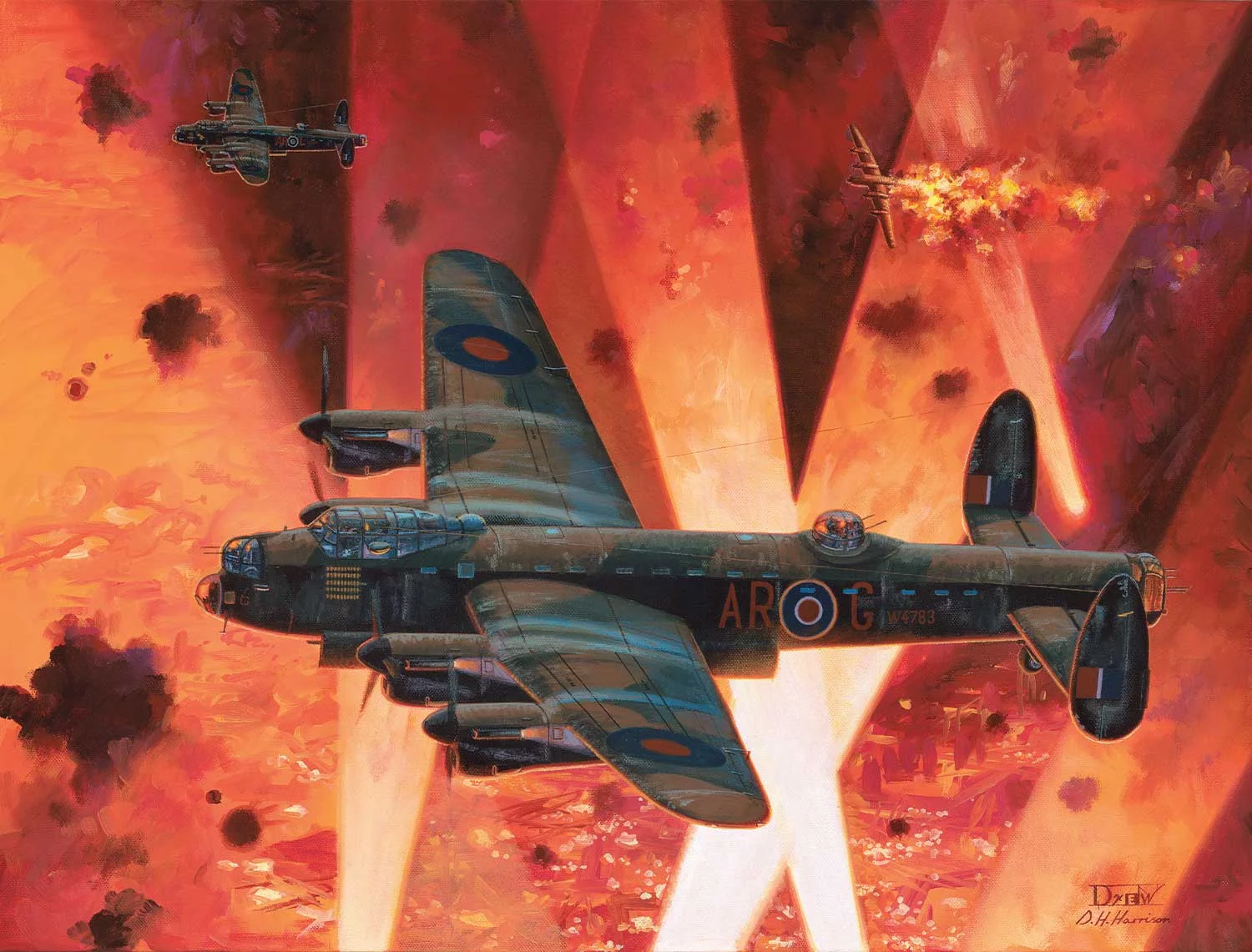
460 squadron RAAF was raised as an Australian manned unit under RAF control as a part of the Bomber Command in the United Kingdom.
Avro Lancaster Mk. I, W4783 arrived on strength of 460 Squadron RAAF during October of 1942. It was assigned the code AR-G, and call sign 'G' for George. During the war AR-G was one of thousands of aircraft and personnel who flew night operations against European targets. No target could have been considered more hazardous than the German capital Berlin. 'G' for George first flew to Berlin on 16 January 1943.
On the night of 3/4 September 1943 the target for 460 Squadron was again in the heart of Germany. At this stage 'G' was captained by F/Sgt Harold 'Cherry' Carter and the mission was his seventh. On this operation 460 Squadron committed a near maximum effort of twenty-four aircraft. Tragically three aircraft failed to return. 460 Squadron RAAF set an enviable record within Bomber Command during WWII, however, the efficiency and accolades came at a cost losing over 180 aircraft on operations and the highest number of casualties for an Australian squadron. 'G' for George completed 90 operations with the Australian unit during WWII and attained the second highest mission tally of all Lancasters. Remarkably it survived and was eventually flown back to Australia and is now exhibited at the Australian War Memorial, Canberra.
P-51D Mustang Limited Edition Medallion
Produced in Australia under license from the US, the P-51D Mustang was assigned to occupation duties in Japan and later took part in the Korean War. Operated by 77 Squadron until April 1951, the Mustangs were used for routine operations in the opening stages of the Korean War and notable missions including the destruction of the rail bridge near Sonchon on December 17, 1950.
The medallion features P-51D Mustangs from Drew Harrison's Cutting the Lines.
-
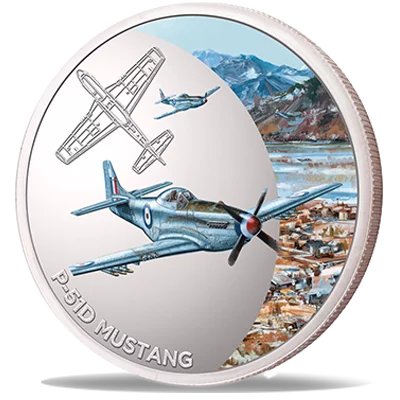
FRONT
-

BACK
-
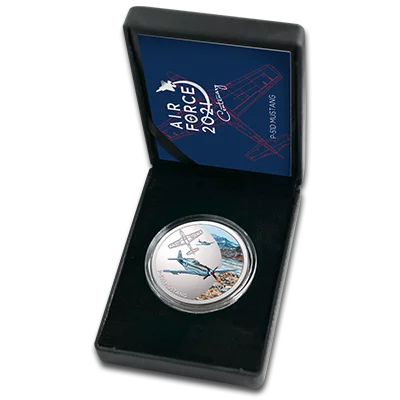
PRESENTATION CASE
-
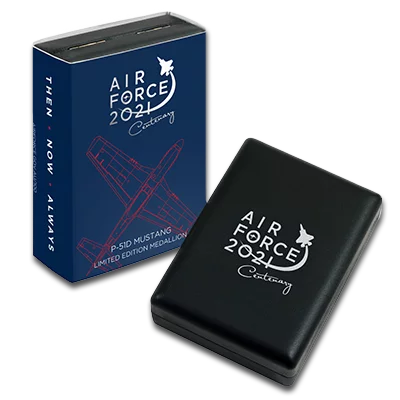
PACKAGING
CUTTING THE LINES
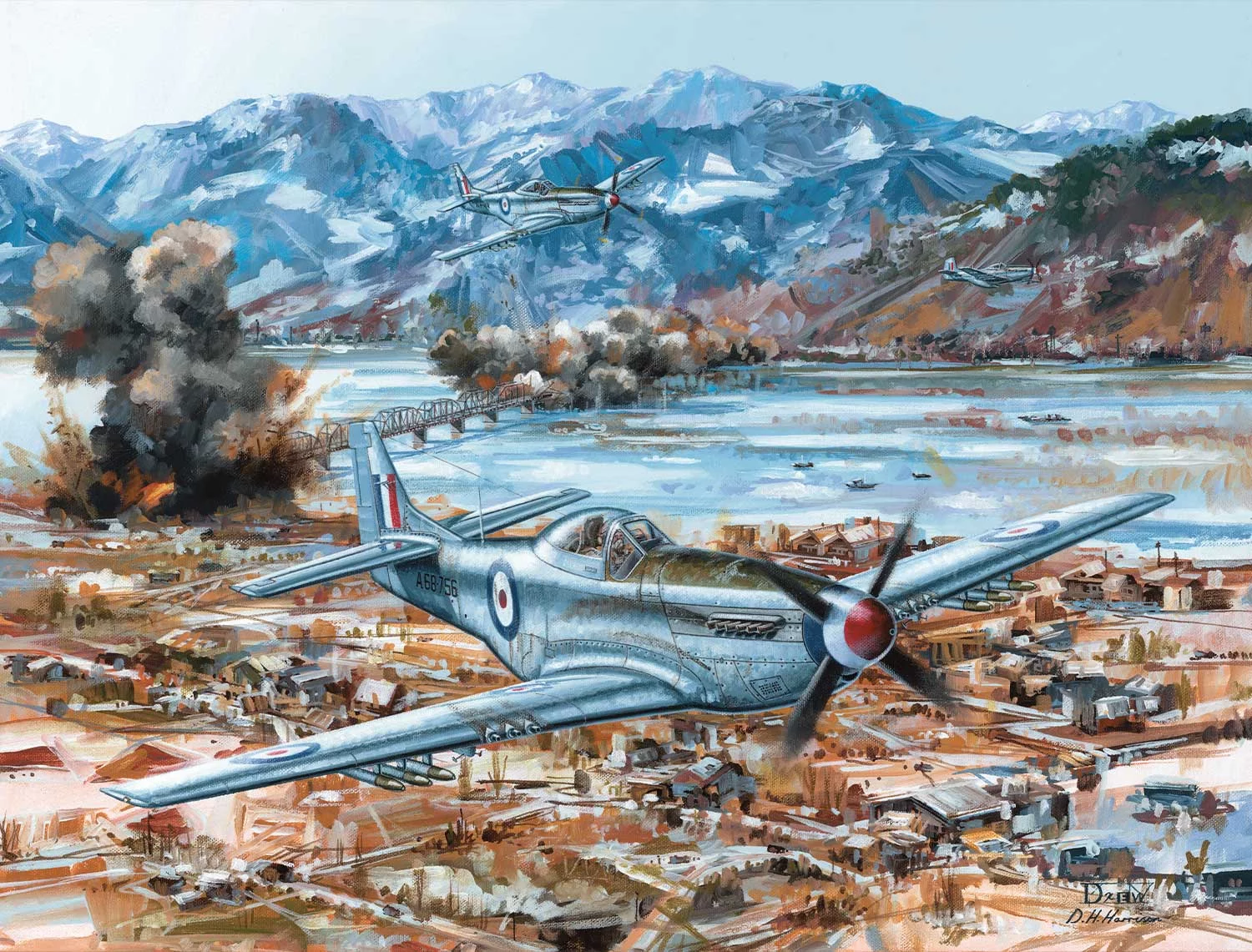
Soon after the cessation of hostilities in WWII the RAAF committed 76, 77 and 82 squadrons as part of the British commonwealth occupational forces (BCOF) in Japan. 77 Squadron remained on station and was due to be recalled in 1950, however, this was cancelled on 25th June when hostilities over the Korean peninsula erupted. The Australian squadron led by S/Ldr Louis 'Lou' Spence (DFC and Bar, MiD) was immediately committed as part of the United Nation response and became second only to the United States in conducting initial combat operations over Korea. 77 Squadron Mustangs began their duties on 2nd July 1950 escorting American bombers to targets, although close support and strike missions became more prevalent.
Following the tragic loss of Spence in August, command of 77 Squadron was succeeded by the legendary S/Ldr Richard 'Dick' Cresswell DFC. During December he had learnt through debriefings that a rail bridge near Sonchon was targeted by B-29s on three separate occasions and all had failed in their task. Sensing an opportunity to enhance the squadron's reputation, Cresswell volunteered a small flight of Mustangs to undertake the same mission. On 17th December four aircraft including F/Lt Des Murphy in P-51D, A68-756 targeted the bridge. Destruction was attained solely with bombs. This was one of hundreds of routine operations flown by 77 Squadron during the opening stages of the conflict. 77 Squadron received a Presidential Citation from The Republic of Korea for operations over the peninsula along with numerous individual awards and citations for the hard-working crews. It remains one of Australia's premier fighter squadrons and is currently re-equipping with the F-35.
Catalina Limited Edition Medallion
Becoming one of the most valuable aircraft during the war against Japan, the long-range Consolidated PBY Catalina patrol flying boats were operated by the RAAF from early 1941 and provided long-range strike capability for the opening stages of the Pacific War. Completing a range of operations, these slow-speed aircraft were flown at night, resulting in the aircraft's black painted exterior, and earning the name 'Black Cats'.
The medallion features a Catalina from Drew Harrison's Black Cat in the Shadows.
-
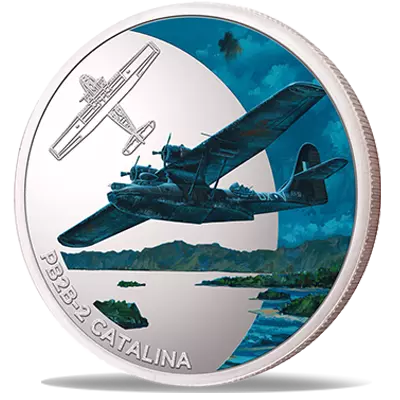
FRONT
-

BACK
-

PRESENTATION CASE
-
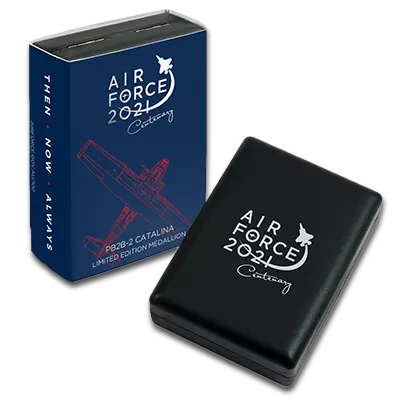
PACKAGING
BLACK CAT IN THE SHADOWS
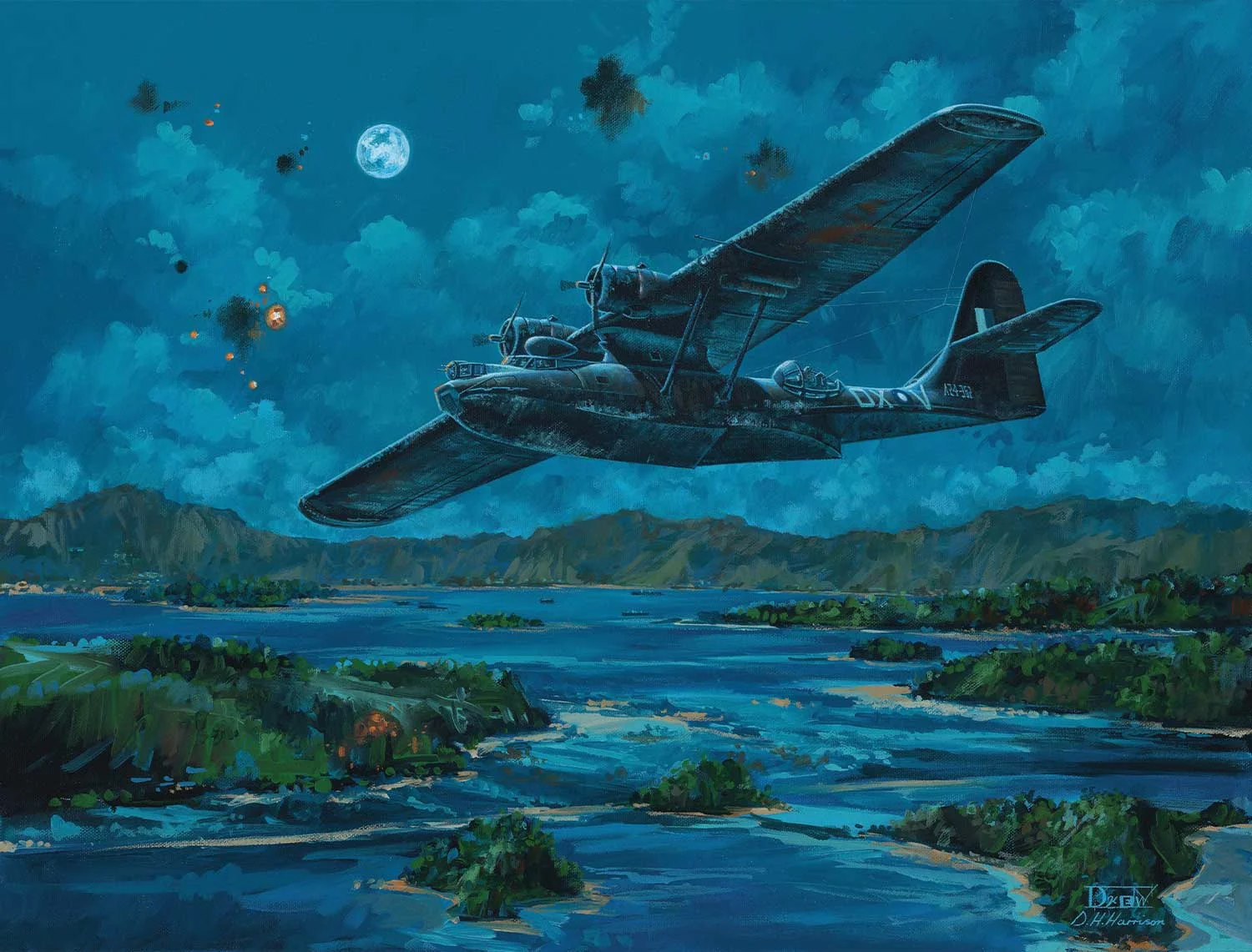
In early 1941 the RAAF acquired a small number of Consolidated PBY Catalina patrol flying boats. Their extreme range made them an ideal platform for many other missions, and they were consequently forced into action in the long range strike role for the opening stages of the Pacific War. Due to the Catalina's slow speed, later combat operations were flown at night which necessitated painting the aircraft all black for concealment.
These soon became known as Black Cats. 43 Squadron RAAF was established as a Maritime Patrol unit equipped with the Catalina in early 1943. By 1945 the squadron continued flying many types of operations including harassment against targets of opportunity across the South West Pacific. On the 21st July 1945 F/Lt John Paine and crew, in a late model Catalina PB2B-2, A24-362 (OX-V), searched for targets of opportunity in the Sawu Sea and generally harassed enemy installations. The same pace of operations continued right up to Japanese capitulation in August. As a tribute to A24-362 and 43 Squadron RAAF, Catalina PBY-6A (VH-PBZ) operated by the HARS Aviation Museum is currently in the markings of this wartime aircraft.
CAC Sabre Limited Edition Medallion
The CA-27 Sabre was a highly redesigned Australian version of the North American F-86. Featuring a more powerful Avon engine, altered fuselage and increased air intake, the CA-27 Sabre was used by 79 Squadron RAAF to maintain patrols and provide air cover at the major airbase in Ubon, Thailand.
The medallion features a CAC Sabre from Drew Harrison's Cobra Sabres.
-

FRONT
-

BACK
-

PRESENTATION CASE
-
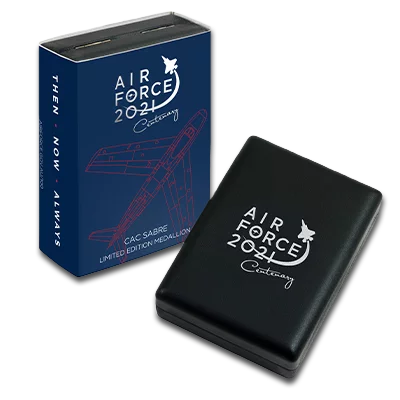
PACKAGING
COBRA SABRES
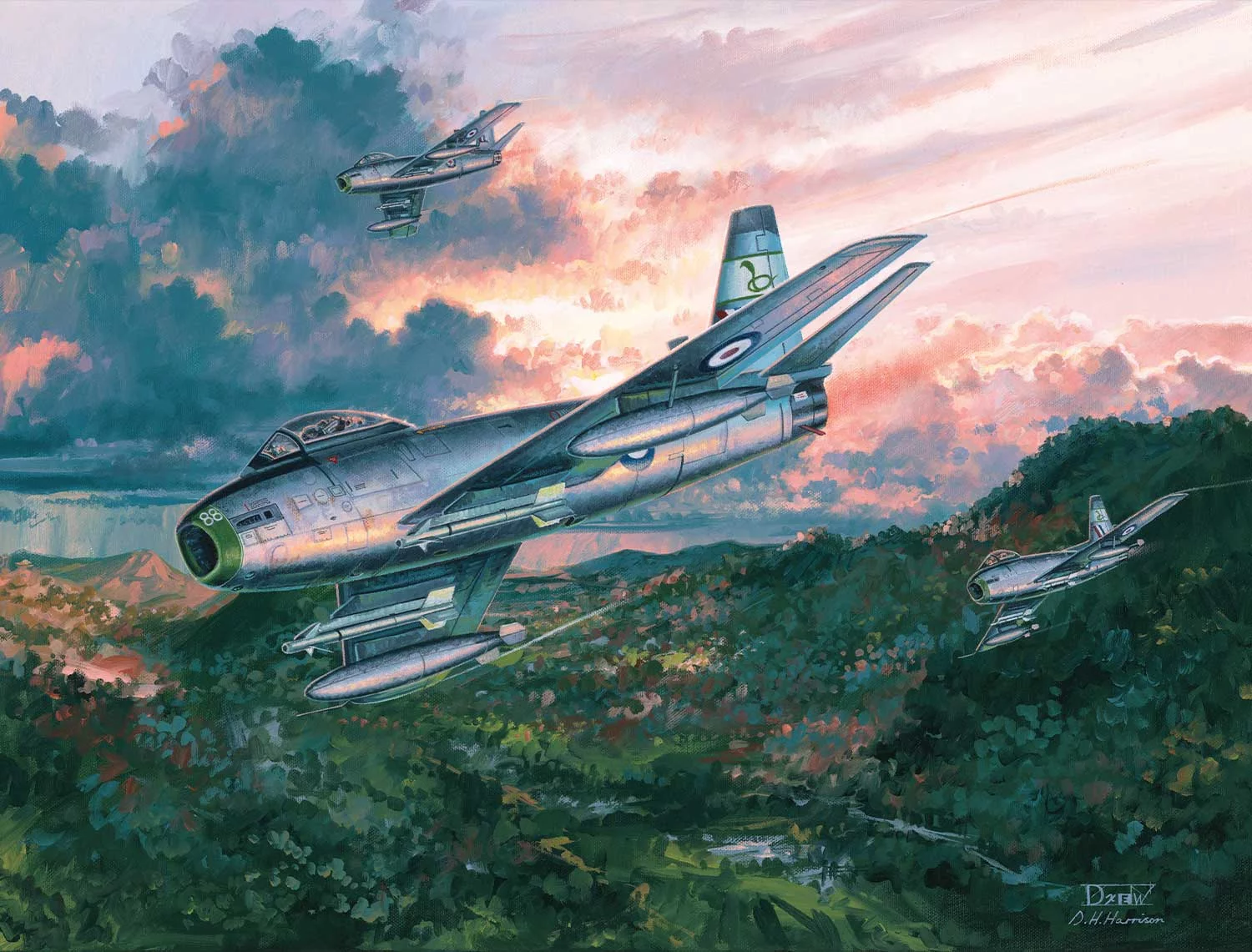
In 1962 members of the Southeast Asia Treaty Organization (SEATO) sent a holding force to Thailand in response to a threat from across the Laotian border. Australia's contribution was 79 Squadron RAAF. In May it was reformed and moved to the Royal Thai Air Force base at Ubon to provide area defence. Equipment was in the form of the Commonwealth Aircraft Corporation (CAC) CA-27 Sabre, a highly redesigned Australian version of the North American F-86. In Thailand the Sabres were kept at constant readiness.
With the escalation of hostilities in neighbouring Vietnam, Ubon became a major air base for F-4 Phantoms of the USAF. 79 Squadron maintained patrols during this time and were often on readiness to intercept returning Phantoms and provide air cover. A stylised green cobra was briefly adopted as a tail marking on several of the CA-27 Sabre Mk.32 fighters including A94-988. Despite 79 Squadron never committing to combat the unit contributed greatly to Thailand's security. In August of 1968 the country's defence was assured and the unit were withdrawn and disbanded for a second time. It would later receive Battle Honours for the Ubon deployment of 1962 to 1968 and has since been reformed on two separate occasions including 1998 to the present day.
Air Force 100 Iconic Aviation Limited Edition Medallion Set of 6
All six of the spectacular Air Force 100 Iconic Aviation Limited Edition Medallions presented in a stunning velvet-lined, timber-finish display box.
Only 1,000 sets will be released.
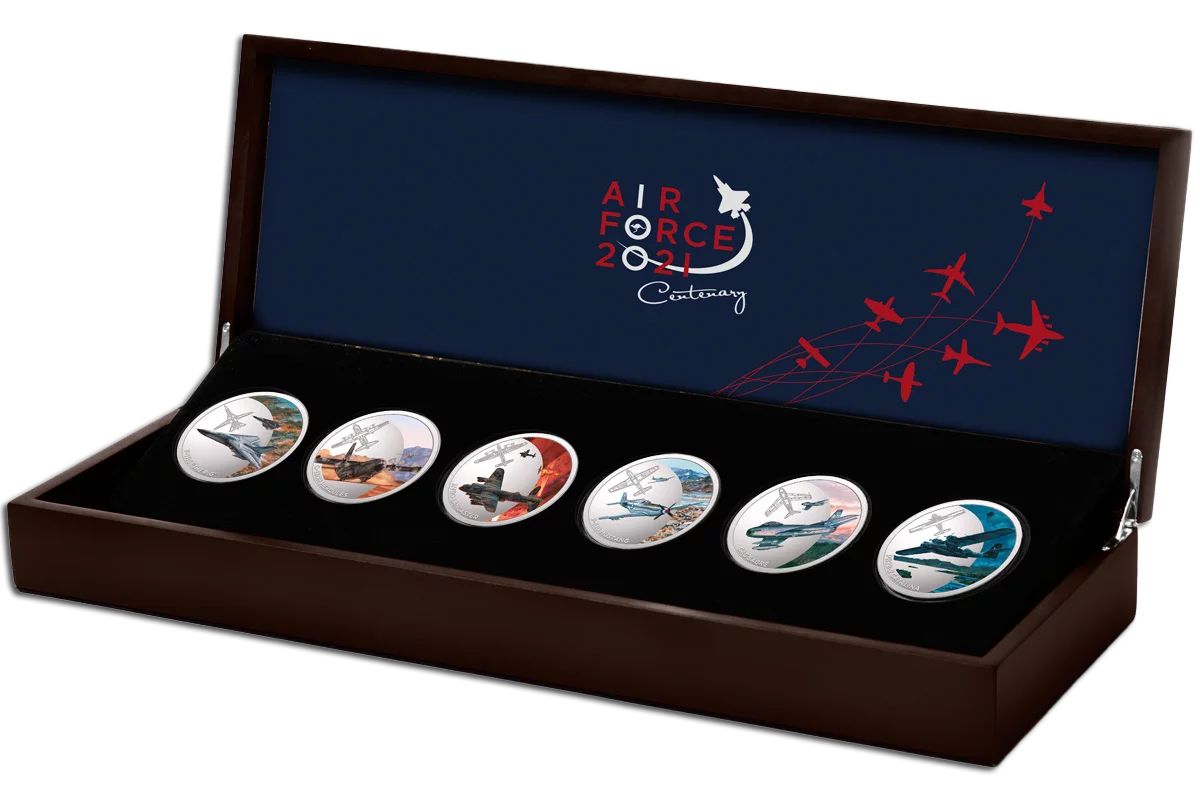
-

F-111C
-

C-130 HERCULES
-

AVRO LANCASTER
-

P-51D MUSTANG
-

CATALINA
-

CAC SABRE
-

BACK
-
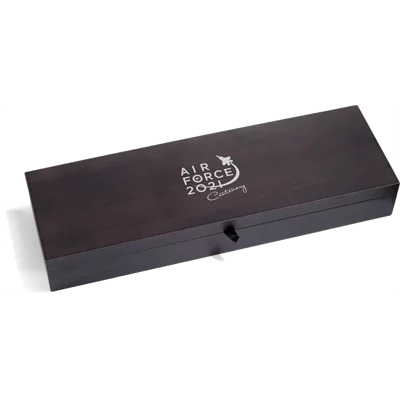
DISPLAY BOX
SERIES I
SPITFIRE MK. VC LIMITED EDITION MEDALLION
The Supermarine Spitfire is the most well known fighter plane of the Second World War. Over 900 aircraft were operated by Nos 451, 452, 453 and 457 Squadrons between 1941-1945.
The medallion features a Spitfire Mk. Vc from Drew Harrison's Pressure Point.
-
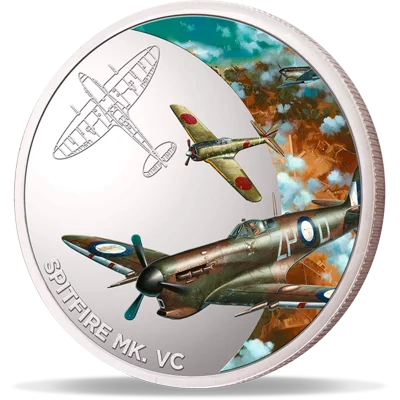
FRONT
-

BACK
-

PRESENTATION CASE
-
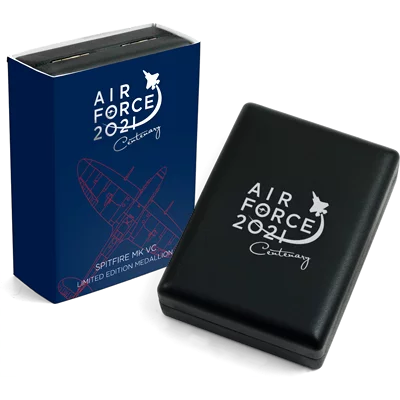
PACKAGING
SOLD OUT
PRESSURE POINT
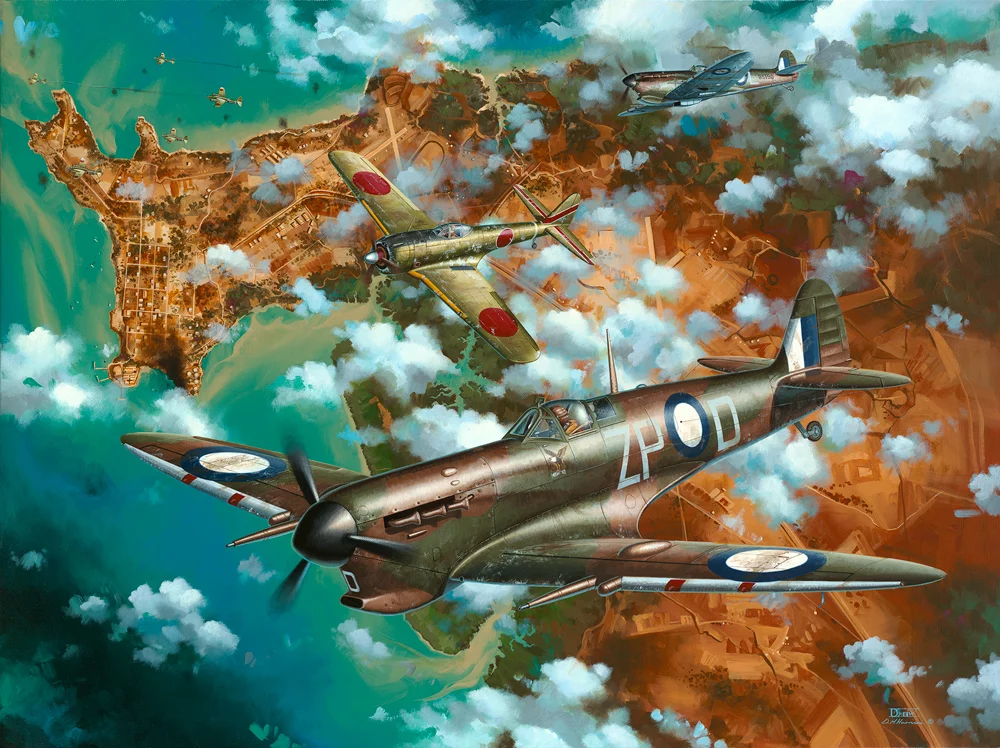
On 20th June 1943 bombers and fighters of the IJAAF bombed Darwin. 452 (Aus) Sqn RAF and 54 Sqn RAF intercepted NE of the harbour while 457 (Aus) Sqn RAF were sent to investigate another plot further north. By the time 457 Sqn re-engaged, Ki-49 'Helen' bombers of the 61st Sentai were almost directly over the township. F/Lt P.H. Watson DFC led the three sections of 457 Sqn Spitfires into a dangerous and difficult head on attack. White flight repeated the manoeuvre, however, John 'Smithy' Smithson (White 3 - ZP-L, BS190), leading the second section of William 'Jack' Halse (White 4 - ZP-D), noted the difficulty of their position and readjusted for a more favourable quarter attack. Smithson fired at one of the bombers in a dive, then pulled up behind the enemy force with Halse sticking to his leader's tail. White 3 managed to get a bead on one of the escorting fighters, a Ki-43 'Oscar' of the 59th Sentai, and opened fire with cannon to claim the enemy destroyed. Another 'Oscar' had latched onto Halse in ZP-D. Both the Australians were now separately engaged and forced to fight their way out.
CANBERRA MK.20 LIMITED EDITION MEDALLION
On 29 May 1953, the first Australian-built Canberra performed its first flight at Avalon Airport, Victoria; this aircraft was delivered to the RAAF for service trials a few weeks later. In December 1953, the Canberra, named after the Australian capital, formally entered Australian service. Canberra continued to be used by Australia for a total of 29 years before its retirement in June 1982.
The medallion features Canberra MK.20 bombers from Drew Harrison's Night Spectres.
-
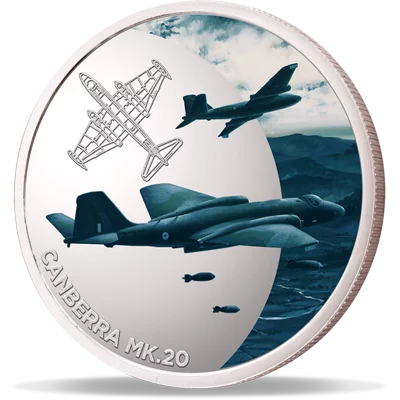
FRONT
-

BACK
-
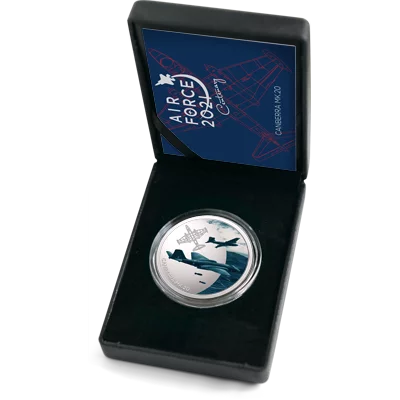
PRESENTATION CASE
-
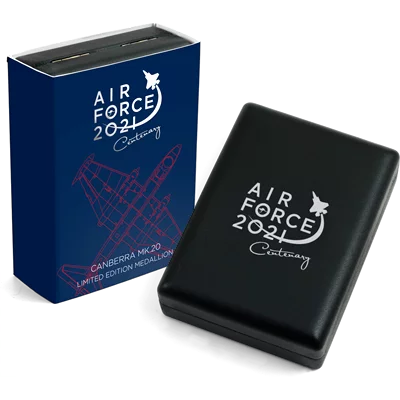
PACKAGING
NIGHT SPECTRES
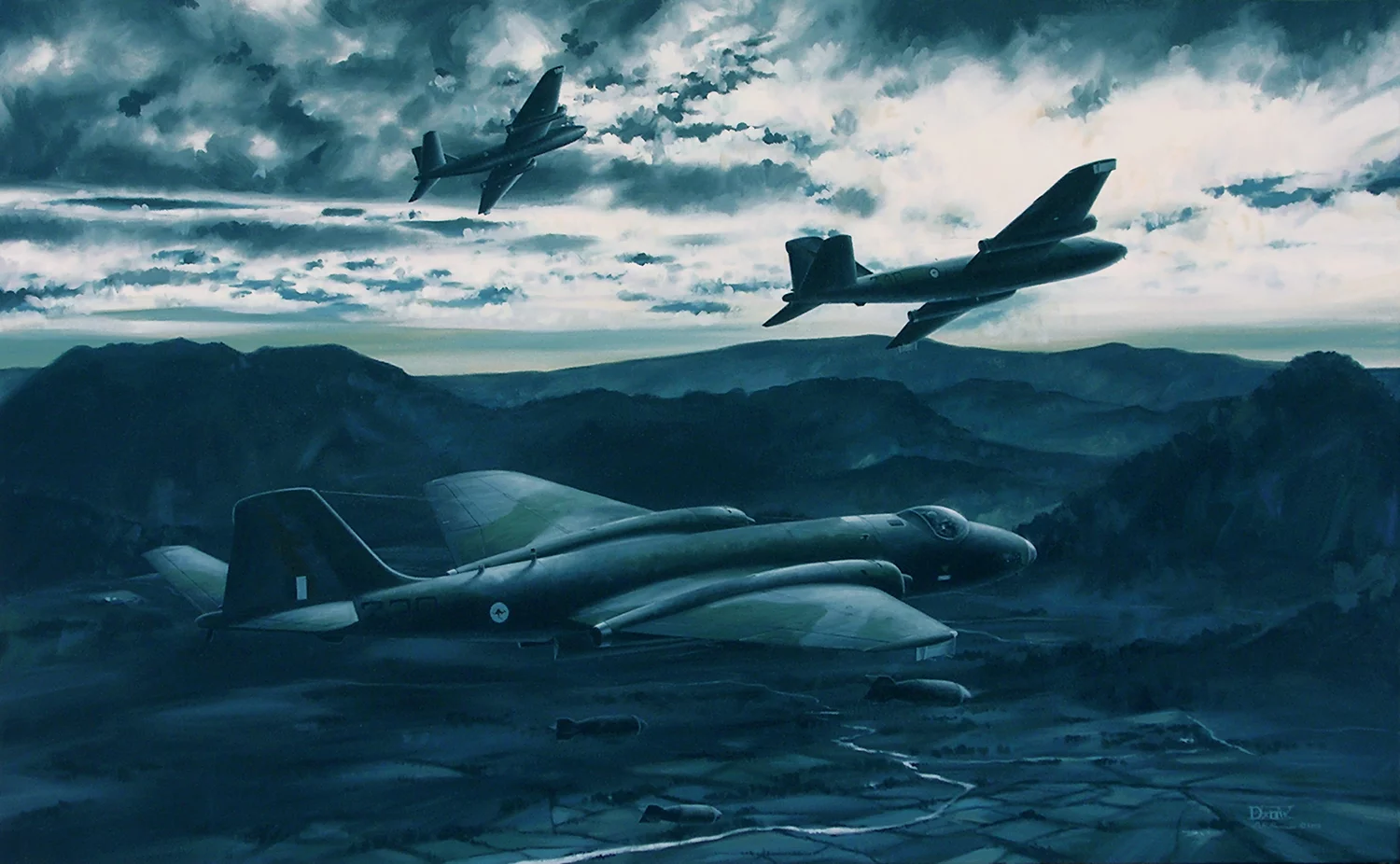
2 Squadron (RAAF) was again in action during the Vietnam War, having seen continued service throughout both World Wars and the Malayan Emergency. Australia had deployed several helicopter squadrons and support units to South East Asia, however, 2 Sqn was the sole RAAF-fixed wing strike capability in South Vietnam. The unit deployed with Canberra bombers in 1967 and was immediately involved on bombing operations. During four years of service the unit was regarded as one of the pre-eminent bomber squadrons. Superb accuracy was achieved on day and night time missions and the dedicated ground crews provided an enviably high rate of aircraft serviceability. Night Spectres depicts Canberra bombers of 2 Squadron (RAAF) striking targets during the early phases of the Vietnam conflict.
MIRAGE III O LIMITED EDITION MEDALLION
The Mirage IIIE powered by the SNECMA Atar engine, was built under license by Government Aircraft Factories (GAF) at Fishermans Bend, Melbourne. Known as the Mirage IIIO or GAF Mirage, the Australian variant differed from the Mirage IIIE mainly in its avionics. 100 aircraft were built, of which 98 were built under licence in Australia. The first 49 were Mirage IIIO(F) interceptors which were followed by 51 Mirage IIIO(A) fighter bombers.
The medallion features a Mirage III O from Drew Harrison's Exercise Kangaroo.
-

FRONT
-

BACK
-
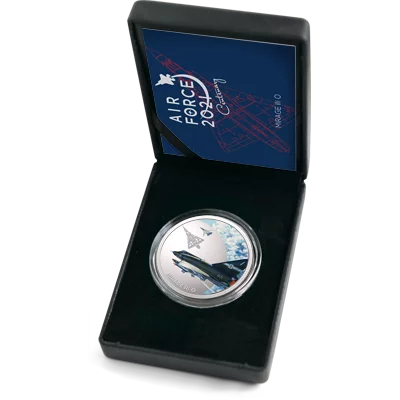
PRESENTATION CASE
-
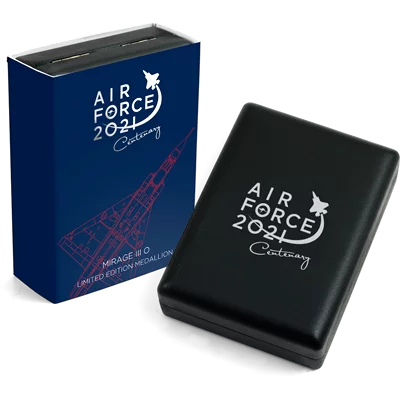
PACKAGING
SOLD OUT
EXERCISE KANGAROO
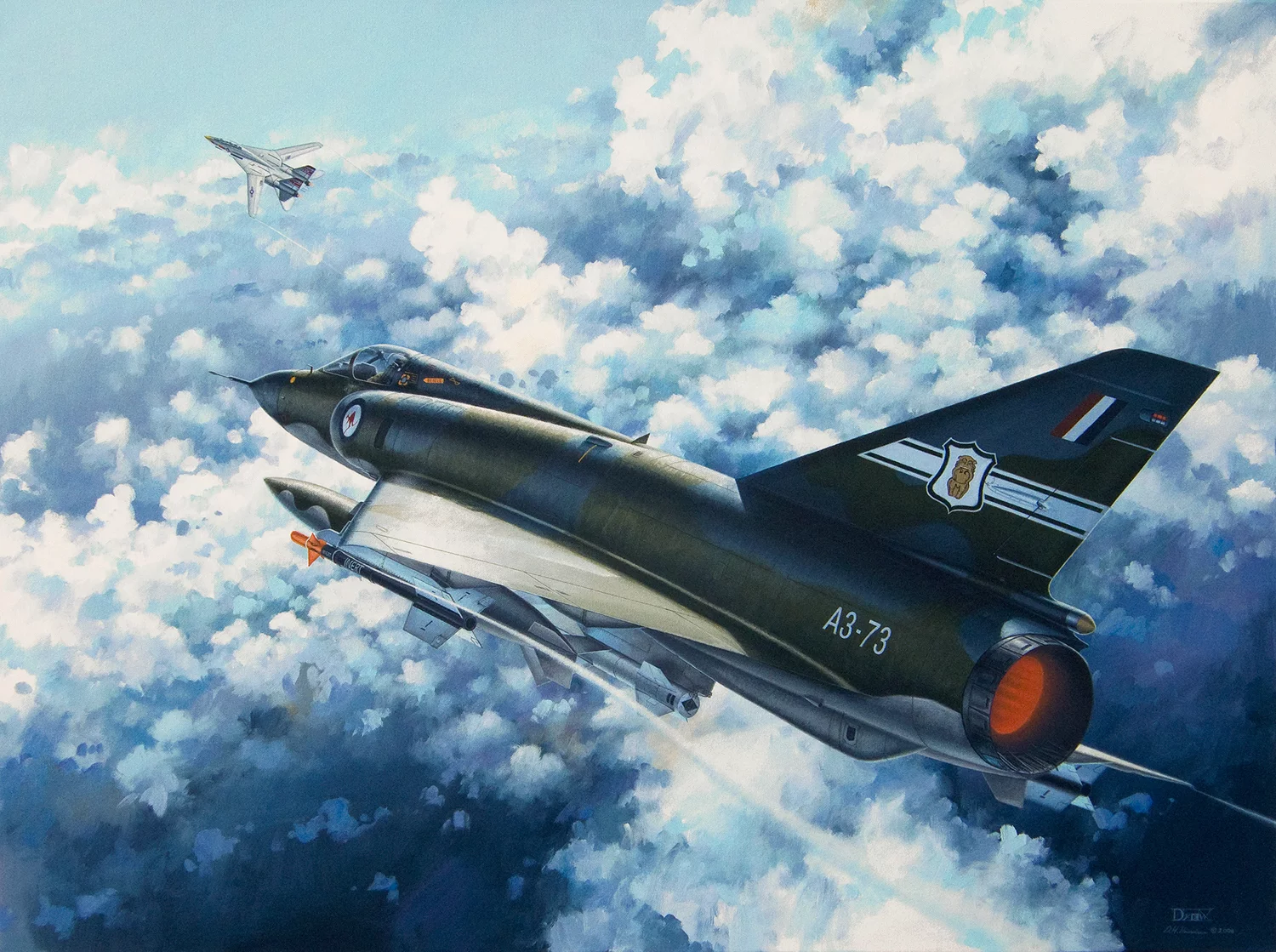
During October of 1976 the United States Navy (USN) and Royal Australian Navy (RAN) along with the Royal Australian Air Force (RAAF) gathered for Exercise Kangaroo II. During the war games, Dassault Mirage III fighters of 77 Sqn RAAF were pitted against F-14 Tomcats in dissimilar aircraft combat tactics. 77 Sqn's adversary was the USN's VF-1 'Wolfpack'. This squadron wielded a new frontline strike weapon - the formidable Grumman F-14 Tomcat. Embarked upon USS Enterprise it was VF-1's first deployment with the F-14. Although an outstanding long-range interceptor the American fighter was no match for the agile Mirage at close quarters. Pilots of 77 Sqn recorded several gun-camera 'kills' against their larger more modern combatants. An outstanding achievement for a fighter that was entering the twilight years of RAAF service.
UH-1B IROQUOIS LIMITED EDITION MEDALLION
The Royal Australian Air Force employed the UH-1H until 1989. Iroquois helicopters of No. 9 Squadron RAAF were deployed to South Vietnam from mid-1966 in support of the 1st Australian Task Force. UH-1 helicopters were used in many roles including troop transport, medevac and Bushranger gunships for armed support. No. 35 Squadron and No. 5 Squadron also operated the Iroquois in various roles through the 1970s and 1980s.
The medallion features a UH-1B Iroquois from Drew Harrison's Hot LZ.
-
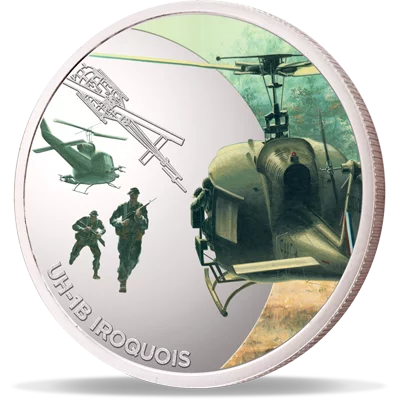
FRONT
-

BACK
-
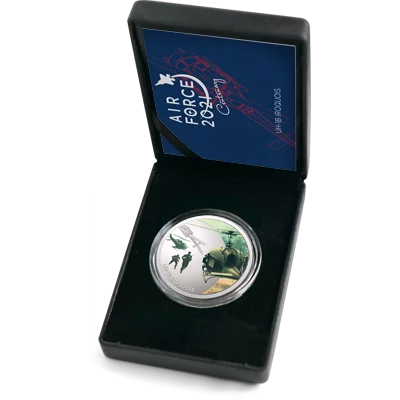
PRESENTATION CASE
-
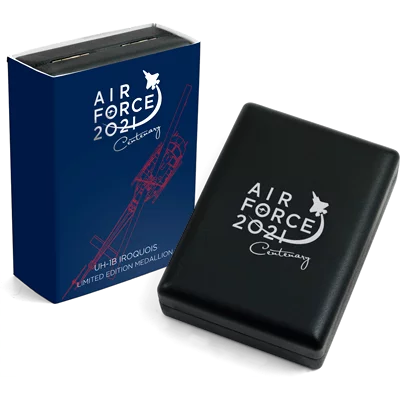
PACKAGING
SOLD OUT
HOT LZ
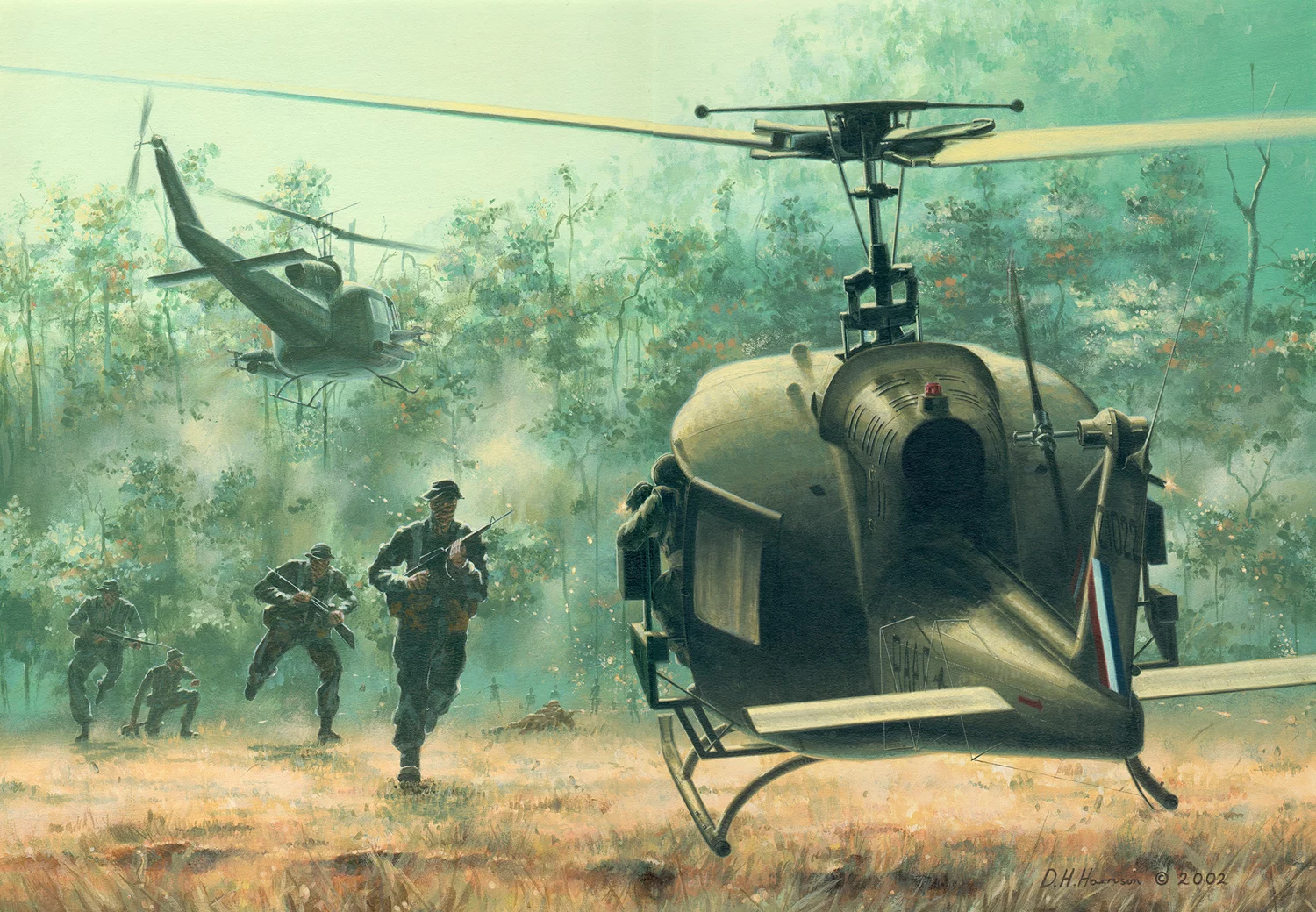
On 10th August 1967 two 9 Squadron RAAF UH-1B 'Hueys' were assigned to provide 'insertion' of an SAS long range reconnaissance patrol approximately fifteen minutes from the squadron's base at Nui Dat. Soon after delivery at the landing zone (LZ) the patrol commander radioed for an immediate retrieval. The small squad had come under intense gunfire from a large force of North Vietnamese Army troops. The helicopters were vectored to a nearby clearing in order to perform a 'hot' extraction, i.e. under enemy fire. Upon arrival the lead helicopter advised that the situation was worsening. Arriving in the second RAAF helicopter, P/O Mick Haxell, P/O Byrnes, LAC McCreadie and LAC Malcolm agreed to perform the retrieval. The crew successfully rescued the troops while Haxell also had to contend with very difficult flying conditions and the subsequently heavily loaded helicopter, all while under automatic weapon fire from the enemy. For his combat actions and other flying duties with 9 Squadron he would be awarded the DFC and later command the unit.
F/A-18A HORNET LIMITED EDITION MEDALLION
The first operational deployment of RAAF Hornets took place in 2001. Following the 11 September terrorist attacks, the Australian Government agreed to deploy F/A-18s to protect the major USAF air base on the Indian Ocean island of Diego Garcia. RAAF Hornets have also provided air defence for several high-profile events in Australia since the 11 September attacks. In 2002, Hornets patrolled over the Commonwealth Heads of Government Meeting (CHOGM) at Coolum Beach, Queensland; this was the first time RAAF aircraft had flown air defence sorties over Australia since World War II.
The medallion features two F/A-18A Hornets from Drew Harrison's Operation Falconer.
-
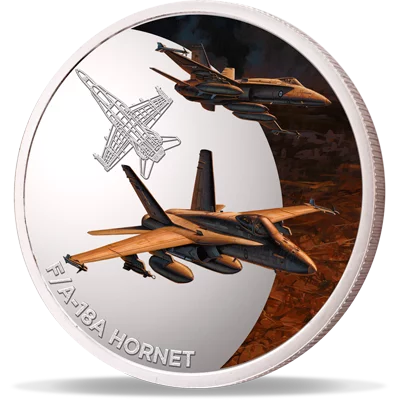
FRONT
-

BACK
-
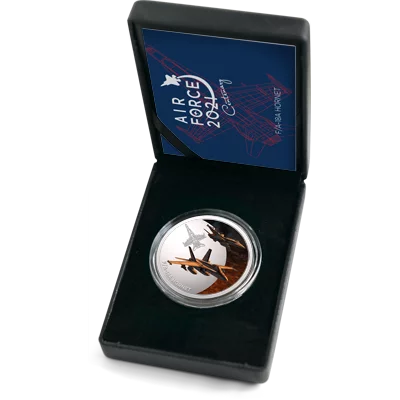
PRESENTATION CASE
-
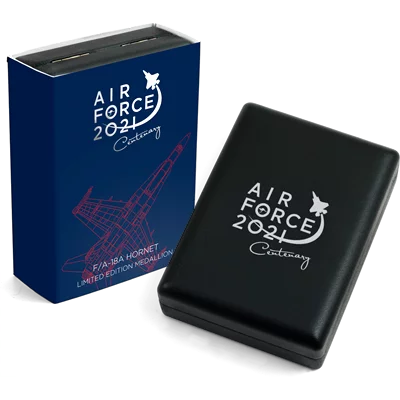
PACKAGING
SOLD OUT
OPERATION FALCONER
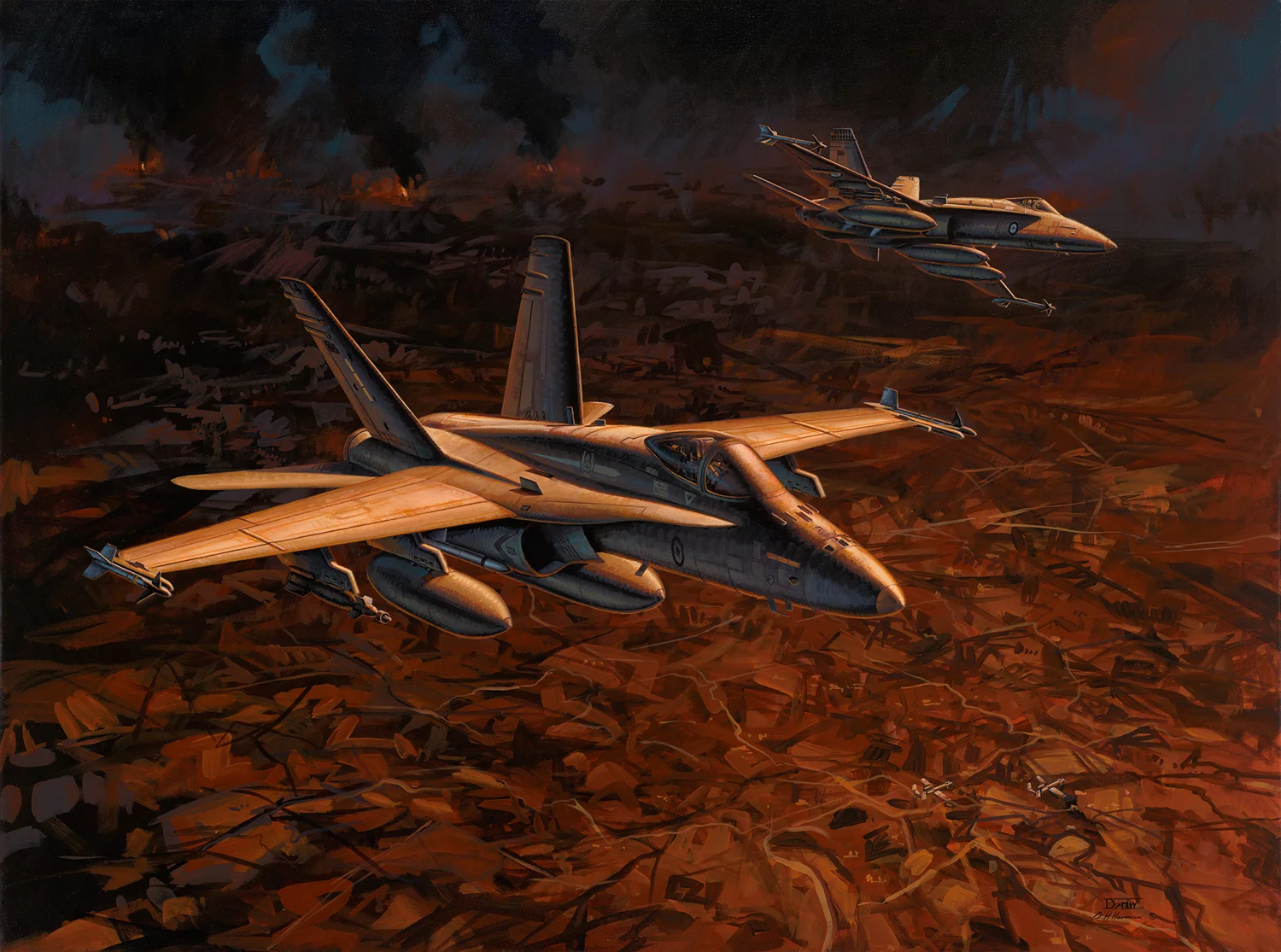
In 2003 the Iraqi Regime under Saddam Hussein failed to comply with United Nation's diplomatic efforts and the Coalition led Operation Iraqi Freedom was launched in response on 19/20th March. A commitment by the Australian Defence Force was initiated under Operation Falconer. The mutli-role capability of the F/A/-18 Hornet was fully tested between 20th March and 2nd May 2003 when the Australian fighter force flew numerous missions ranging from strike and close air support to defensive operations. On 1st April 2003 S/Ldr Glen Beck and his wingman, F/O John Haly, flew a typical strike against Iraqi armour on the roads of South Eastern Iraq. Following marking of targets by USAF A-10s the two Hornets successfully dropped their laser guided GBU-12 bombs before exiting the combat zone. Although most of the deployed aircraft were drawn from 75 Squadron RAAF the Hornets wore a variety of markings reflecting the crews from 3, 75 and 77 Squadrons RAAF.
C-17A GLOBEMASTER III LIMITED EDITION MEDALLION
The Royal Australian Air Force took delivery of its first C-17 in 2006 with it arriving in Canberra, on the 4th of December that year. The aircraft was formally accepted in a ceremony at Fairbairn shortly after arrival. All the Australian C-17s are operated by No. 36 Squadron and are based at RAAF Base Amberley in Queensland
The medallion features a C-17A Globemaster II from Drew Harrison's Global Outreach.
-
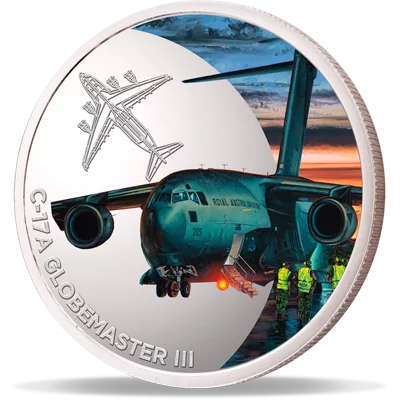
FRONT
-

BACK
-
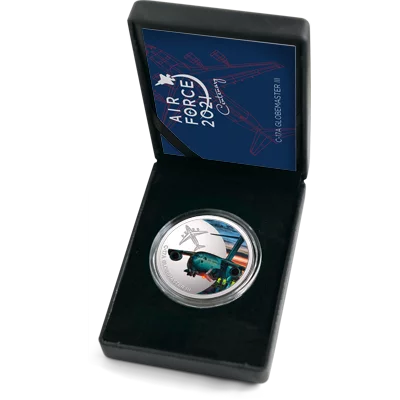
PRESENTATION CASE
-
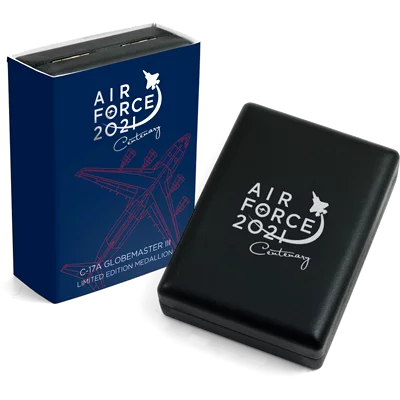
PACKAGING
GLOBAL OUTREACH
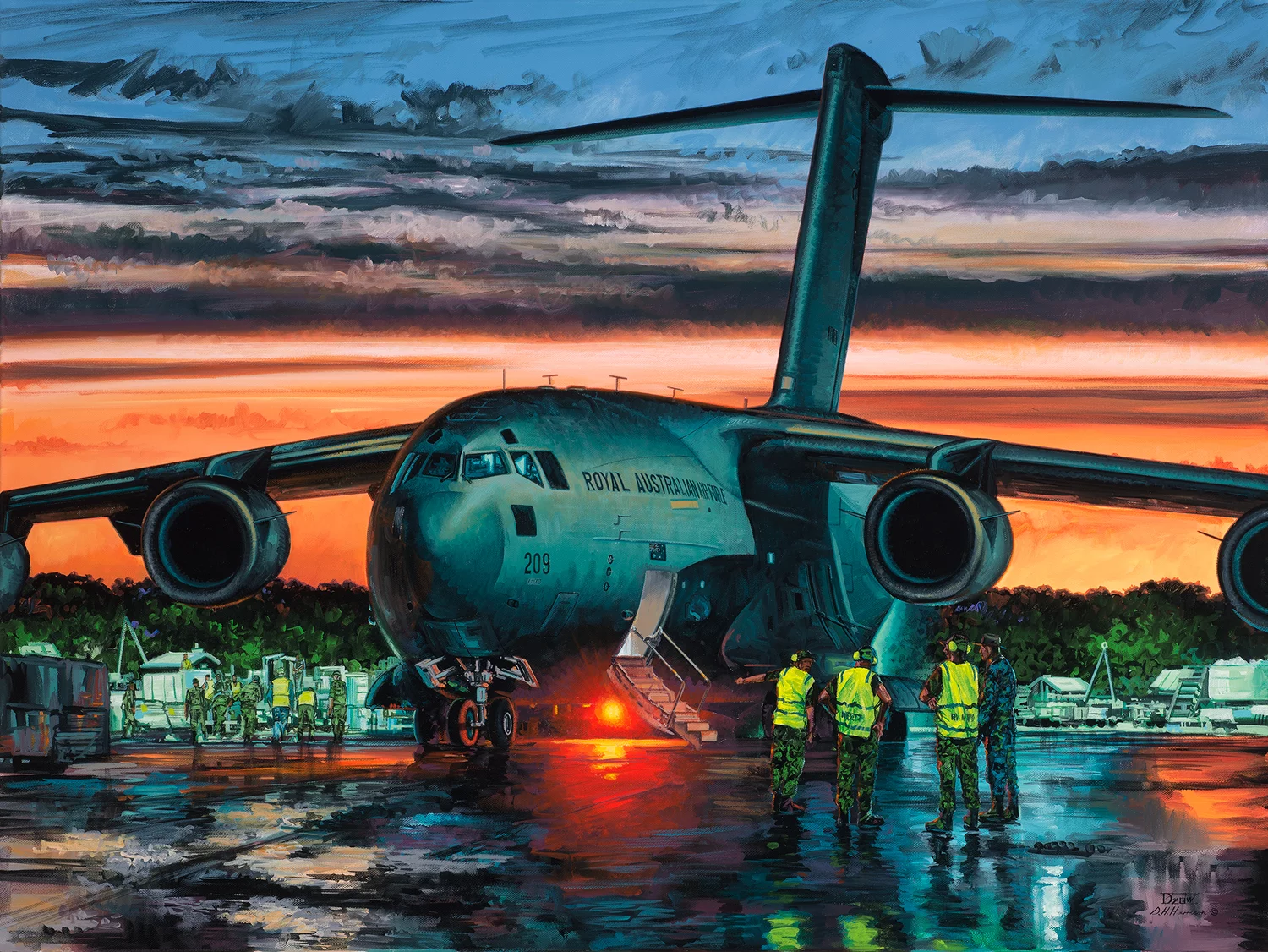
The impressive Boeing C-17A Globemaster III was entered into Royal Australian Air Force service during 2006. Since then the massive transport aircraft have supplemented the C-130 Hercules fleet. Globemasters have greatly extended the RAAF's strategic airlift capabilities providing the versatility to rapidly deploy vehicles, troops and supplies anywhere in the world. In 2016, 36 Squadron's C-17s at Amberley are regularly on operations and include support for humanitarian and disaster relief missions. In these latter roles Globemasters have provided an unrivalled outreach to supply Australian Aid during missions such as Operation Philippines Assist – the response to Typhoon Haiyan.
AIR FORCE 100 SET OF SIX LIMTED EDITION MEDALLIONS
All six of the spectacular Air Force 100 Limited Edition Medallions presented in a stunning velvet-lined, timber-finish display box.
Only 1,000 sets will be released.
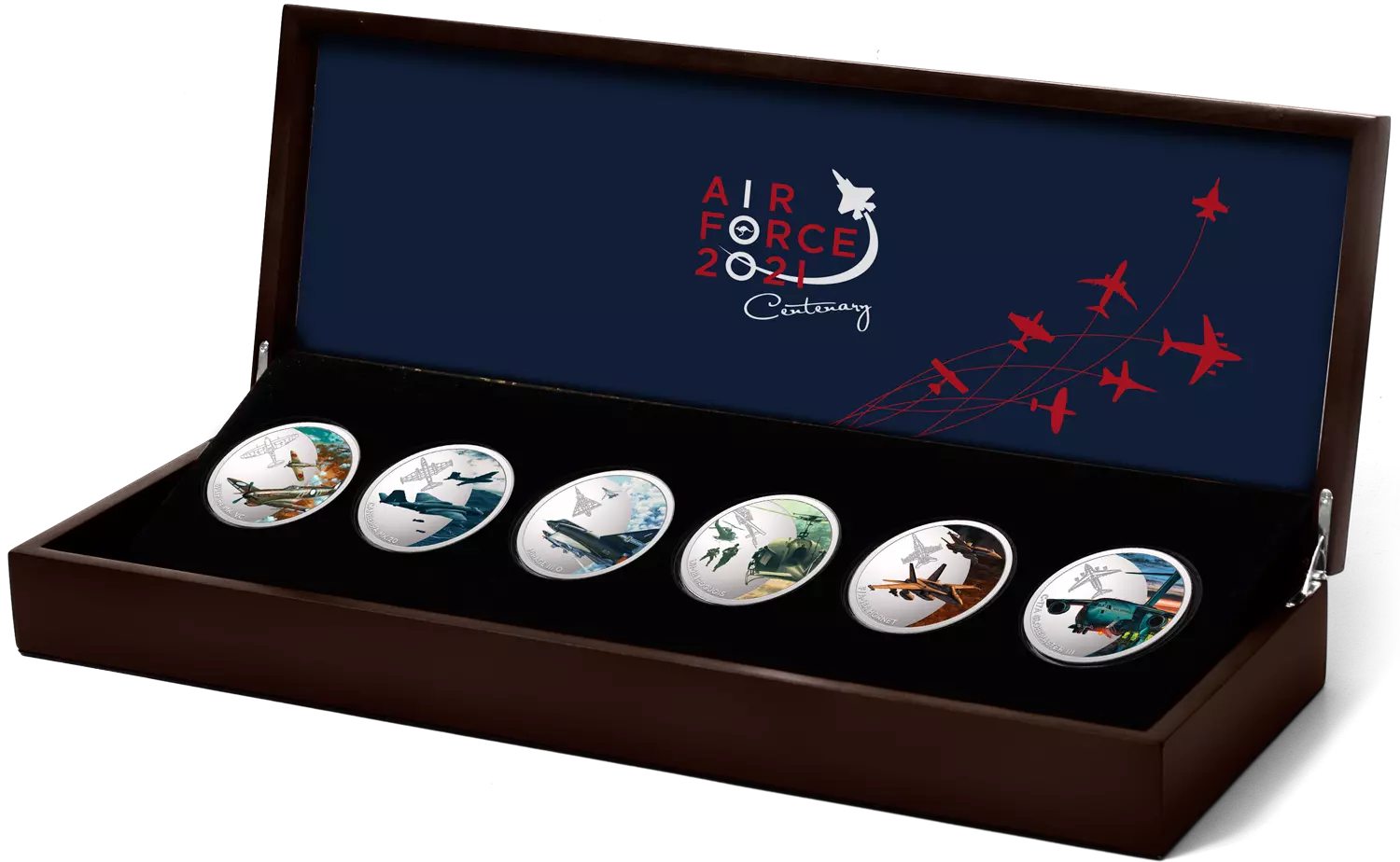
-

SPITFIRE MK. VC
-

CANBERRA MK.20
-

MIRAGE III O
-

UH-1B IROQUOIS
-

F/A-18A HORNET
-

C-17A GLOBEMASTER III
-

BACK
-

DISPLAY BOX






